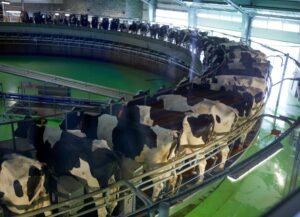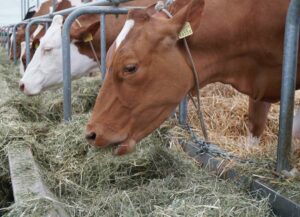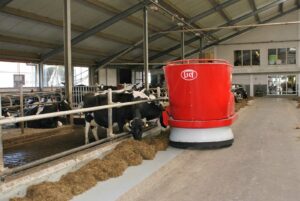Mercedes González & Nuria Garcia
Bovine tuberculosis (TB) is a zoonotic disease, which not only affects cattle but also humans. The World Health Organization estimates that about 10 million people per year contract tuberculosis, and of these approximately 1 million die each year. An important part of these figures is the result of bovine TB, which is transmitted by consuming milk that has not been treated correctly, or by coexisting with, and treating animals.
Tuberculosis is a very serious and difficult disease to treat, has a worldwide distribution, and is considered one of the biggest global public health problems. As such, it is essential to implement good prevention measures to prevent infections. In addition, TB causes significant economic losses on dairy cattle farms due decreased milk production of affected animals and condemned carcasses due to granulomatous lesions in meat or lungs.
The simplest, cheapest, and most effective method to control and eradicate bovine TB is to perform the tuberculin intradermal test, which in addition is currently standardized. Many countries do it officially to detect infected animals and remove them from the herds. The destination of these animals is usually the slaughterhouse as means to cut-off the transmission between animals, and therefore also humans.
The tuberculin test involves injecting a small amount of antigen (purified protein derived from the bacterium) in the skin of the cow and measure the thickness of the reaction that occurs. When this thickness exceeds a certain set standard, the animal is considered positive and will be culled, because of the risk of transmission to other animals or people (by contact and/or through milk). However, there could also be other effective and simple TB screening methods to be used on farms.
Usefulness of mid-infrared spectroscopic analytical techniques in dairy farms
For years, mid-infrared spectroscopy (MIR) analytical techniques have been applied on dairy farms. It is a technique widely used in the food industry to detect the presence of various substances. It is based on the excitation and vibration of the molecules present in the material analyzed by projecting an infrared beam of light from certain spectrum (frequency of 4000 to 400 cm-1).
In the food industry, MIR analyses are generally used to detect fraud or adulteration. On dairy farms it has long been used as an efficient, routine and a low-cost prediction of fat and protein content in milk. Some studies have shown its usefulness as a predictive method to assess milk fatty acids, cow energy status, methane emissions, ketone bodies, and even pregancy status.
In other places such as the United Kingdom, milk MIR data is routinely recorded on many farms and turned to artificial intelligent systems. The latter have algorithms with deep learning capability that use complex computational models, which through statistical methods investigate the relationship between milk components and some important characteristics of the farms to be studied.
For example, they have created deep convolutional neural networks (artificial intelligence systems) in which cow gestation data are associated with the results of MIR milk analyses. It has been documented that milk infrared spectra have specific characteristics related to the gestation and metabolic states of cows. As a result, a model can be created that has a significantly high predictive accuracy to detect the onset or loss of gestation.
This was the case with tuberculosis in a study conducted in the UK (Denholm et al., 2020). The researchers combined data obtained from the national database of the tuberculin screening program with information obtained from the MIR analyses of milk to feed the artificial neural network, which would routinely predict the tuberculosis status.
Data from more than 1,600,000 cows from UK dairy herds were included, providing information to the national registration system. The database was fed with milk production and composition records, animal age, tuberculin test results, skin injury status, microbiological cultures, and slaughterhouse results. Data on animal movements, births and deaths were also added.
Specificity and sensitivity of the tuberculin test for detecting tuberculosis in dairy farms
The tuberculin test has a high specificity (above 99.9%), which indicates its ability to detect animals that are disease-free when they are negative to the test. However, the sensitivity (ability to correctly detect animals that are sick when the test is positive) is not as high with an 80% average.
This means that most cows that test negative to tuberculin will be truly negative, so from the point of view of public health and animal health one is reassured there are no sick animals left that can transmit tuberculosis to other animals or humans. However, of the animals that test positive, there are some that could be sick or not, which results in economic losses.
The gamma interferon test is more expensive and has a higher sensitivity (85-90%) but somewhat lower specificity (96.6%). The MIR analysis method proved to be an innovative, low-cost and non-invasive tool that provided information on the cow’s health status and enabled animal management and welfare decisions. This is a good complement to official TB control measures, so it could be an aid in their control and eradication, surveillance, outbreak management, and prevention of transmission by wildlife.
The results obtained with this study open-up new possibilities for application with other diseases of interest, such as paratuberculosis (Johne’s disease) a chronic and contagious enteritis produced by Mycobacterium avium subsp. Paratuberculosis.
Conclusions
This study concluded that deep learning networks based on analysis of the average infrared spectrum of milk is a promising method to predict TB status in individual dairy cows. The system proved able to alert, with an accuracy of 95%, which cows might fail tuberculin tests. Predictions correlated solidly with the actual values.
This would be a useful tool for ranchers, as automatic prediction during milking of each cow could make it easier to make decisions about those cows that might be possibly reactive to the test (and therefore infected). It could prove to be a useful routine tool in the future.
Reference
Scott J. Denholm, Werner Brand, Andrew P. Mitchell, Abbygail T. Wells, Tomasz Krzyzelewski, Stephanie L. Smith, Eileen Wall, Mike P. Coffey. Predicting bovine tuberculosis status of dairy cows from mid-infrared spectral data of milk using deep learning. Journal of Dairy Science. 2020 Oct; 103(10): 9455-9367.
© 2021 Dairy Knowledge Center. All Rights Reserved.











